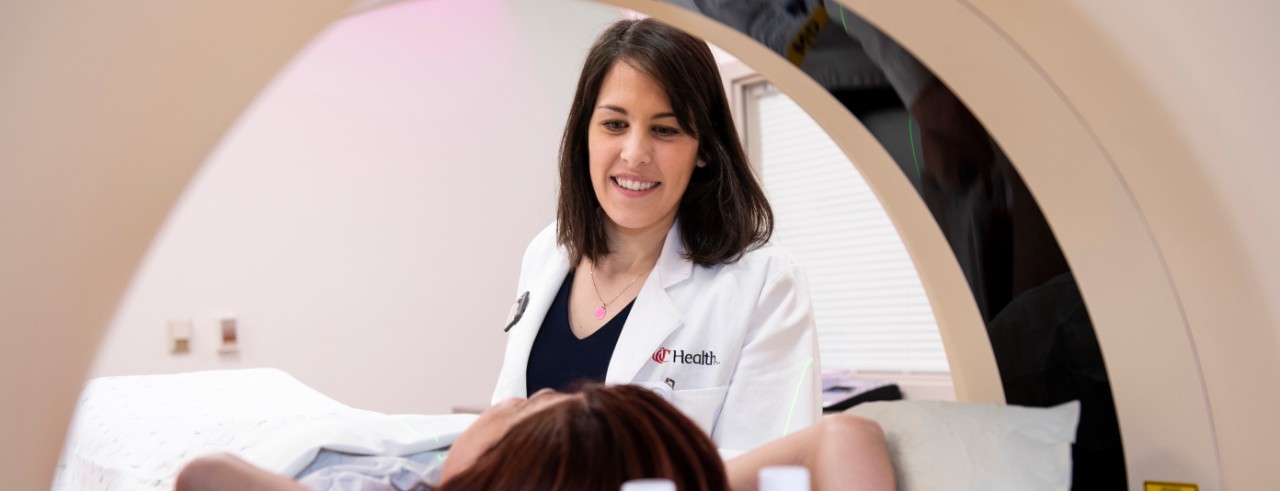
FLASH radiation therapy shows promise in first-in-human trial
Treatment found safe and effective for pain relief in small trial of patients with metastatic cancer
A new first-in-human trial led by University of Cincinnati researchers suggests a certain radiation treatment, which delivers therapeutic doses of radiation in a fraction of a second, may hold promise as a potential treatment for tough-to-kill tumors.
The technology, called FLASH radiation treatment (FLASH RT), previously tested in animals, was shown to be as safe and appeared to be as effective as conventional radiation without causing unexpected side effects in the study in a small number of people with bone cancer. Findings of the FAST-01 trial were published in JAMA Oncology and presented Oct. 23 at the American Society for Radiation Oncology (ASTRO) annual meeting.
“Our study shows FLASH radiotherapy with protons is a practical modality to reduce pain,” said Emily C. Daugherty, MD, second author of the study and an assistant professor of clinical radiation oncology at the University of Cincinnati Cancer Center. “It deserves further exploration because of its potential to decrease the side effects associated with conventional radiation treatments.”
FLASH radiotherapy delivers radiation at dose rates that are more than 300 times higher than those used in conventional radiation treatments. This induces a phenomenon known as the FLASH effect, which reduces the harm that may occur to normal tissue surrounding a tumor during conventional radiation therapy, while still killing the cancer cells at the tumor site.

A gantry, or treatment room, at the Cincinnati Children's/UC Medical Center Proton Therapy Center. Photo/Colleen Kelley / UC Marketing + Brand.
“Because FLASH radiotherapy, which is given at ultrahigh dose rates, appears to cause less normal tissue injury, it offers the possibility of delivering larger doses of radiation which could result in higher cure rates for patients with resistant tumors without increasing side effects of treatment,” said John Breneman, MD, principal investigator on the trial and a professor of radiation oncology at the University of Cincinnati Cancer Center.
Most early research on FLASH RT used electron beams to deliver the radiation, but these beams don’t penetrate very deep into tissue, limiting its applicability for this treatment approach. Using proton beams for ultrahigh-dose radiation allows for penetration sufficient to reach tumor locations in most people.
While preclinical trials with animals suggested FLASH RT could safely deliver high doses of radiation with fewer harmful side effects, prior to the FAST-01 trial, the treatment had never been tested under a clinical trial in humans.
In this study, ultrahigh dose rate radiation was delivered to 10 patients, ages 27-81 years, each with one to three painful bone metastases in their extremities. Treatments were delivered to a cumulative 12 metastatic sites in patients’ arms and legs.
Pain, use of pain medications and adverse events were measured on the day of treatment, 15 days following treatment, and at one, two and three months following treatment. Researchers continued measuring these results every two months for up to 13 months. The median follow-up was 4.8 months.
Researchers chose patients who would have received conventional radiation therapy at the same dose as they were given with FLASH RT.
“We used the exact same regimen, but with FLASH dose radiation. The patient experience is the same as it would have been receiving conventional radiation, only the treatment delivery process is shorter,” Daugherty said.

John Breneman, MD, speaks with a patient. Photo/UC Health.
Following FLASH RT, seven of the 10 patients experienced complete or partial pain relief. Of the 12 treated sites, pain was relieved completely for six sites and partially for two additional sites. Temporary pain flares occurred in four of the 12 sites treated.
Side effects from treatment were mild. Four patients experienced mild skin hyperpigmentation (darkening skin tone), one experienced skin discoloration, two experienced mild limb swelling or puffiness, two experienced itchy skin, one experienced fatigue, one experienced reddening of the skin and one experienced extremity pain.
Each FLASH treatment takes about three-tenths of a second, Daugherty explained. Following treatment, “both pain relief and side effects were in line with what might have happened with conventional radiation. We did not see any unexpected additional toxicity with the substantially shorter treatment.”
FLASH RT would potentially be most useful in treating hard-to-kill cancers in the brain, lungs or gastrointestinal area, where healthy tissue surrounding tumors is particularly vulnerable to radiation exposure, Breneman said. However, clinical trials in these sites cannot be authorized until studies show ultrahigh dose rate radiation is safe and effective in other, less sensitive areas. The Food and Drug Administration limited its approval for this study to adults with bone metastases in their arms and legs, areas at much lower risk should complications arise.
“From a practical standpoint, this is not the type of cancer that FLASH is designed to treat, but we need human data to see if there are any unexpected side effects. Treating arms and legs is not as risky as treating someone’s brain or lungs,” said Breneman, who also serves as medical director of the Cincinnati Children's/UC Medical Center Proton Therapy Center.
Ultimately, FLASH RT could also be useful in treating pediatric cancers, since children are more sensitive to the side effects of radiation therapy, he said. But much more research needs to be done before that can occur.
Researchers don’t fully understand why FLASH RT kills tumors with fewer side effects than conventional radiation and further research is needed to determine the biological mechanisms driving the FLASH effect, Daugherty said.
Next, the research team will test the safety and efficacy of FLASH RT with patients who have metastases closer to the lungs and heart. The FAST-02 trial is currently enrolling adult patients with thoracic bone metastases.
Other members of the UC College of Medicine's Department of Radiation Oncology involved during sessions/presentations at ASTRO 2022 include:
- Bailey Nelson, MD, "Feasibility Trial of IMPT to Reduce Toxicity in Anal Cancer Patients" poster presentation, opening remarks at ARRO 01 annual seminar
- Vinita Takiar, MD, Track Chair for Head and Neck Education for the annual meeting, "Applying for Jobs" session panelist and chair/moderator at "Treating the Toxicity: Survivorship Following Head and Neck Cancer Radiotherapy" panel session
- Jordan Kharofa, MD, "Radiolytic Escherchia coli Nissie: A Novel Radiosensitizer Delivery Platform Using Live Bacterial Therapeutic" presentation
- Teresa Meier, MD, "Evaluating the Role of Adjuvant Radiation Therapy in Node-Positive Male Breast Cancer Patients Using the NCDB" poster presentation
- Kevin Lui, MD, "Penile Bulb Dose Predicts Sexual Quality of Life after Prostate SBRT: Secondary Analysis of a Multi Institutional Trial" presentation
- Luke Pater, MD, lead of "The Pediatric Cancer Poster Q&A" poster walk
The research team was also led by John P. Perentesis, MD, research director of the Proton Therapy Center, and Anthony Mascia, PhD, chief physicist for the center. The FAST-01 (NCT04592887) and FAST-02 (NCT05524064) trials are funded by Varian Medical Systems.
Featured photo at top of Dr. Daugherty with a patient. Photo/Colleen Kelley/UC Marketing + Brand.
Related Stories
UC COVID-19 studies awarded $425K
April 15, 2020
Understanding that time was of the essence in combating this highly infectious disease, UC and its College of Medicine’s Office of Research conducted a rapid review and distribution of $425,000 in novel pilot grants to researchers, focusing on eradicating the disease.
Educational breast cancer event focuses on empowerment
Event: November 3, 2018 9:00 AM
"Beyond Breast Cancer: The Path to Empowerment” is an educational event for breast cancer survivors, their families and the community; it will be held from 9 a.m. to 3 p.m. Saturday, Nov. 3, at the Kingsgate Marriott Conference Center, 151 Goodman Drive.
Yahoo News: Five Black UC faculty members receive National...
September 8, 2020
Five African-American researchers and healthcare professionals on UC’s medical campus have received sizable grants from the National Institutes of Health during the past 18 months. The faculty members were interviewed by WCPO to help showcase innovation and the diverse voices and perspectives they bring as the healthcare community attempts to ease health disparities in communities of color in Cincinnati and beyond.
